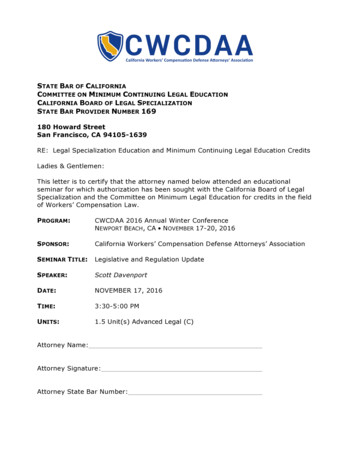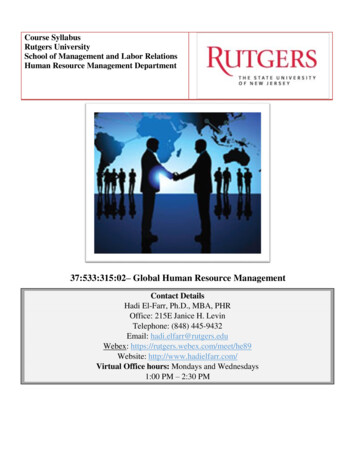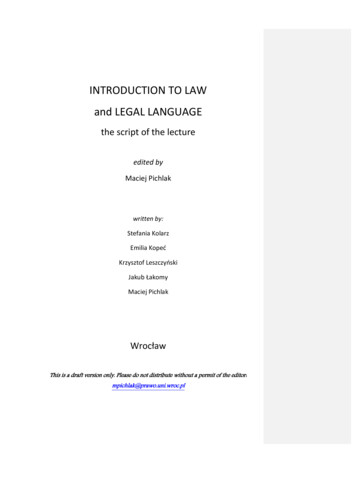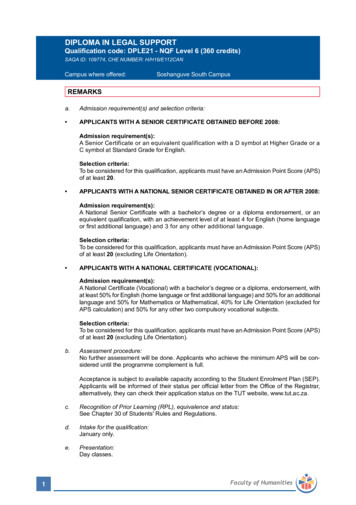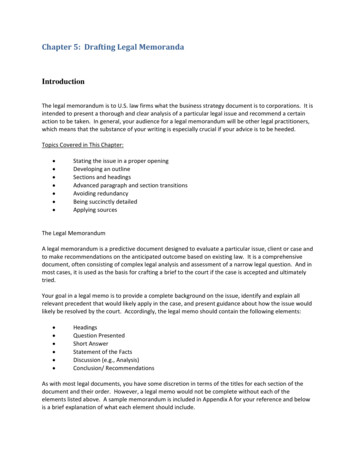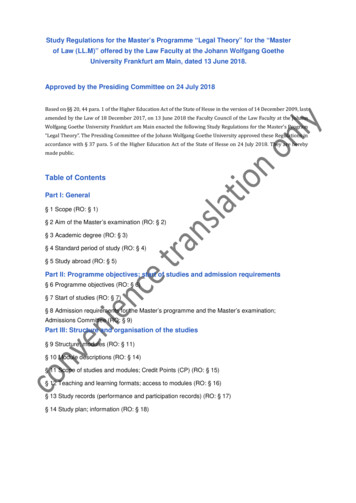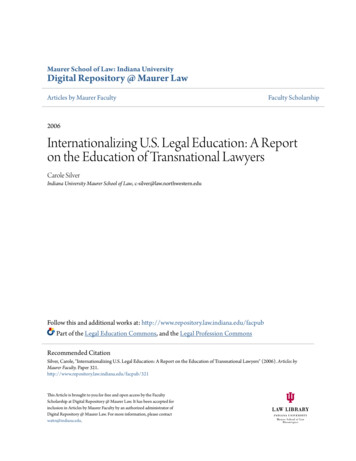
Transcription
Maurer School of Law: Indiana UniversityDigital Repository @ Maurer LawArticles by Maurer FacultyFaculty Scholarship2006Internationalizing U.S. Legal Education: A Reporton the Education of Transnational LawyersCarole SilverIndiana University Maurer School of Law, c-silver@law.northwestern.eduFollow this and additional works at: http://www.repository.law.indiana.edu/facpubPart of the Legal Education Commons, and the Legal Profession CommonsRecommended CitationSilver, Carole, "Internationalizing U.S. Legal Education: A Report on the Education of Transnational Lawyers" (2006). Articles byMaurer Faculty. Paper 21This Article is brought to you for free and open access by the FacultyScholarship at Digital Repository @ Maurer Law. It has been accepted forinclusion in Articles by Maurer Faculty by an authorized administrator ofDigital Repository @ Maurer Law. For more information, please contactwattn@indiana.edu.
INTERNATIONALIZING U.S.LEGAL EDUCATION: A REPORT ON THEEDUCATION OF TRANSNATIONAL LAWYERSCarole Silver*ABSTRACTThis Article analyzes the role of U.S. law schools in educating foreign law graduates and the increasingly competitive global marketfor graduate legal education. U.S. law schools have been at theforefront of this competition, but little has been reported abouttheir graduate programs. This Article presents original research onthe programs and their students, drawn from interviews with directors of graduate programs at thirty five U.S. law schools, information available on law school web sites about the programs, andinterviews with graduates of U.S. graduate programs. Finally, theArticle considers the responses of U.S. law schools to new competition from foreign universities for the job of educating the world'slawyers.INTRODUCTIONU.S. legal education reflects the essentially local character oflaw: students in U.S. law schools spend most of their time studyingU.S. federal and state court cases, statutes, regulations, and thepolicies underlying them. And despite claims that globalization isleading to unified legal standards, much of law remains uniquelylocal, embodying local customs, legitimizing local moral judgments,and enforced, adopted and interpreted by legislators and judgeswho are selected directly or indirectly by the residents they willgovern. Nevertheless, increasing numbers of lawyers originally educated outside of the U.S., whose work is centered outside of theU.S., are enrolling in U.S. law schools for graduate legal education.* Senior Lecturer, NorthwesternUniversity School of Law.The informationpresented in this Article was presented at the 2004 AALS meeting for the Section of Graduate Legal Education in Atlanta. I am deeply grateful to the graduate directors, faculty,and graduates of LL.M. programs who so generously shared their time and experienceswith me. Many thanks also to Francisco Javier Aguilar Noble, LL.M. 2003 NorthwesternUniversity School of Law, for excellent and thorough research assistance, and to MaryDaly, Nicole De Bruin, John O'Hare and Oscar Stephens for valuable comments on earlierdrafts.
144CARDOZO J. OF INT'L & COMP. LAW(Vol. 14:143Most of these lawyers are practitioners whose interest in U.S. law ispragmatic rather than academic. Given the law's local nature, thisinterest might be surprising. This Article takes this phenomenonas its starting point in examining U.S. law school graduate programs for foreign law graduates.'U.S. graduate programs serve several functions in the development of careers of transnational lawyers. They provide an important link in the professional networks of transnational lawyers; theyoffer graduates credibility (including important experience in legaland business English) that enables them to connect with elite national and international law firms and raise their status in theirhome country legal professions; and they equip graduates with alegal terminology crucial for participation in the international legalservices market.But what benefit do U.S. law schools gain from offering graduate programs for foreign law graduates? And how did they become leaders in the business of global legal education? Section I ofthis Article considers these issues in the context of the growth ofthe international market for legal services. Section II presents basic data about the graduate programs for foreign law graduates offered by U.S. law schools. This data previously has not beenavailable, perhaps because the American Bar Association, thetraditional repository of information about U.S. legal education,does not directly regulate the graduate programs; rather, it "acquiesces" in the existence of the programs. The absence of regulationcorresponds to an absence of data in this instance: schools are notrequired to disclose details about their graduate programs and inmost cases they are reluctant to do so. Section II is based on information about the graduate programs gathered from law school websites2 and supplemented by detailed information provided by the1 Graduate programs include a one-year degree, including the LL.M., whether generalor specialized in focus, MCL (masters of comparative law), MCS (masters of comparativestudies), and MALS (masters of American legal studies). All of these are included in thisstudy. A doctorate in law (SJ.D. or JSD) is outside the focus of the Article.2 The 102 schools listed in Table 1, infra, offer 189 graduate programs available toforeign law graduates. The particular programs seem to be quite fluid - what is describedon a website may not correspond to the description of programs in a brochure that wasprinted a year earlier. This Article relies on web sites to provide the most accurate andrecent information, based on the assumption that web sites are the most likely source ofinformation for foreign law graduates contemplating application to U.S. law schools andthe resulting incentive to keep web site program descriptions current.
2006]INTERNATIONALIZING U.S. LEGAL EDUCATION 145directors of graduate programs at thirty-five law schools.3 SectionIII combines this law school data with the perspective of studentsin U.S. graduate programs to present a broader account of the roleof graduate students and programs in U.S. legal education. Finally,Section IV considers the increasing competition in the graduate legal education market and the challenges facing U.S. law schools.I.CONTEXTUALIZING THE GROWTH OF THE MARKET FORGRADUATE LEGAL EDUCATION IN THE U.S.U.S. law schools long have attracted foreign law graduatespursuing academic careers. Studying in the U.S. was a prerequisiteto securing an academic appointment in many countries and U.S.graduate programs were supportive of this academic approach:earlier generations of graduate programs were focused on the production of a thesis that would be particularly useful to a career inthe academy. After graduation most scholars returned to theirhome countries, as they had intended when they initially enrolled.The U.S. law school experience was a credential valued in theirhome countries and the experience of studying in the U.S. did notsway them from their original career plans.The global political and economic changes that occurred in the1980s and 1990s explain much about the shift in the focus of graduate law programs from scholars to practitioners. This was a periodof tremendous change on the international scene. The financialmarkets witnessed the development of an international derivativesmarket based upon the earlier market for swaps, which broughtinvestment bankers and lawyers together in a contest for innovation.4 The fall of the Berlin Wall in 1989 opened new markets, andthe reduced role of the state in national economies required private resources to assume increasing significance. By the early1990s, cross-border investments were supporting the developmentof international capital markets and transnational investment wasbooming. 5 Lawyers helped to finance these political and economicchanges. U.S. law firms expanded internationally during this period by opening foreign offices and increasingly representing for3 The detailed information was gathered in late 2003 through conversations andemails.4 On the development of the derivatives market, see Schuyler K. Henderson, Regulation of Swaps and Derivatives: How and Why, 8 J. INT'L BANKING L. 349 (1993).5 See generally, J. WILLIAM HICKS, INTERNATIONAL DIMENSIONS OF U.S. SECURITIESLAW ch. 3 (Nicola Padfield ed., 2005).
146CARDOZO J. OF INT'L & COMP. LAW[Vol. 14:143eign governments and private enterprises. 6 They competed fiercelyin European capitals and, where local regulation permitted, in Asiaas well. In 1998, when the American Lawyer published its first"Global Fifty" list of law firms ranked by size and revenue, U.S.firms occupied thirty slots of the fifty largest firms internationally,and all but seven of the top fifty ranked by revenues.7The prominence of U.S. law firms in the international legalmarket supported the developing interest of foreign law graduatesin U.S. legal education. Equally important, U.S. lawyers increasingly represented foreign corporations and governments in theirquest for financing. Further, U.S. corporations were expandingglobally as well, needing local representation in addition to the services offered by their U.S. counsel. In order to represent U.S. businesses and to participate in the growing market for internationaladvice, foreign lawyers perceived that they needed to be able tospeak the same language as U.S. lawyers, both literally andconceptually.II.GRADUATE PROGRAMS FOR TRANSNATIONAL LAWYERS:THE DATAThe number of transnational lawyers attending U.S. graduatelegal education programs has increased over the last decade or so,as has the number of graduate programs offered by U.S. lawschools. This part of the Article examines the who, what andwhere of the graduate law phenomenon.Graduate programs offered by 102 U.S. law schools are opento foreign law graduates. One-third of the schools offering theseprograms are public institutions; all 102 schools are listed in Table1. The graduate programs available to foreign law graduates comprise only approximately fifty-five percent of all graduate programsoffered by U.S. law schools; that is, there are nearly as many graduate programs only for U.S. lawyers (J.D. graduates) offered by U.S.law schools as there are programs for foreign law graduates.6 See Carole Silver, Globalization and the U.S. Market in Legal Services - ShiftingIdentities, 31 J. L. & POL'Y INT'L Bus. 1093 (2000).7 John E. Morris, The Global 50, AM. LAW., Nov. 1998, at 45.8 See the ABA's list of post-J.D. programs at tJ.D.-school.html. In addition to the variety of LL.M. programs offered byU.S. law schools, just over thirty schools offer SJ.D. programs. SJ.D. programs typicallyrequire between one to three years in residence and completion of a thesis.
2006]INTERNATIONALIZING U.S. LEGAL EDUCATION 147TABLE 1: SCHOOLS WITHLL.M.PROGRAMS IN WHICH FOREIGNLAWYERS MAY ENROLIAlabama, U. ofAlbany Law SchoolAmerican U.Arizona, U. ofArkansas, U. ofBaltimore, U. ofBoston U.Brigham Young U.California ia-HastingsCalifornia-Los Angeles(UCLA)Capital U.Cardozo School of LawCase Western Reserve U.Chicago, U. ofChicago-KentCleveland StateColumbia U.Connecticut, U. ofCornell U.Denver, U. ofDePaul UniversityDuke U.Emory U.Florida State U.Florida, U. ofFordham U.Franklin Pierce LawCenterGeorge Mason U.George WashingtonGeorgetownGeorgia, U. ofGolden Gate U.Hamline rdHawaii, U. ofHofstra U.Houston, U. ofHoward U.Illinois, U. ofIndiana U.(Bloomington)Indiana U. (Indianapolis)Iowa, U. ofJohn Marshall School ofLawLewis and Clark CollegeLouisiana State U.Loyola U. (Chicago)Loyola MarymountUniversityMiami, U. ofMichigan State U.,DetroitMichigan, U. ofMinnesota, U. ofMissouri, U. of(Columbia)Missouri, U. of (KansasCity)New England School ofLawNew York U.Northwestern U.Notre Dame, U. ofPace U.Pacific, U. of(McGeorge)Pennsylvania State U.Pennsylvania, U. ofPepperdine U.Pittsburgh, U. ofSaint Louis 0.101.102.San Diego, U. ofSan Francisco, U. ofSanta Clara U.Seattle U.Southern California, U.ofSouthern Methodist U.St. John's U.St. Mary's U.St. Thomas U.Stanford U.Stetson. U.Suffolk U.SUNY BuffaloTemple U.Texas, U. ofTouro CollegeTulane U.Tulsa, U. ofUtah, U. ofValparaiso U.Vanderbilt U.Vermont Law SchoolVillanova U.Virginia, U. ofWake Forest U.Washington and Lee U.Washington U. (St.Louis)Washington, U. ofWayne State U.Whittier Law SchoolWidener U.Willamette U.William and MaryCollegeWisconsin, U. ofYale U.The number of schools with graduate programs available toforeign law graduates increased more than fifty percent in the fiveyear period between 1998, when sixty-seven schools offered graduate programs in which foreign law graduates could and did enroll,and 2003. 9The schools offering graduate programs in which foreign lawgraduates may enroll are a diverse group in terms of their rankingin U.S. News & World Report. These rankings are unrelated to thequalities of the graduate programs for foreign law graduates; thegraduate programs themselves are not ranked (unless they are con9 1998 information is based upon comments made by J. Richard Hurt, then-DeputyConsultant on Legal Education for the ABA, as part of his presentation to the Conferenceon Post-J.D. Education for Foreign Lawyers held at Duke University School of Law(Spring 1999) (on file with author).
148CARDOZO J. OF INT'L & COMP. LAW[Vol. 14:143sidered part of another category, such as tax, for example). Rankings are considered here only as one indication of a variety of theschools sponsoring the graduate programs. Forty-six percent of theTable 1 schools occupy a spot in the first tier of the U.S. Newsrankings. 10 Figure 1 illustrates the U.S. News ranking of the 102law schools offering graduate programs open to foreign lawgraduates.1: U.S. NEWS RANKINGS FOR ALL LAW SCHOOLS WITHLL.M. PROGRAMS OPEN TO FOREIGN LAW GRADUATESFIGUREFirst Tier Second Third Tier FourthTierTierFigure 2 divides the 102 Table 1 schools offering graduate programsfor foreign law graduates between public and private institutionsfor each of the U.S. News tiers.1110 Based on 2003 law school rankings, there are forty seven schools with programs opento foreign law graduates in Tier 1, twenty four schools in Tier 2, fourteen schools in Tier 3,and seventeen schools in Tier 4. For current rankings, see Complete Guide to LawSchools: Rankings, available at /lawindexbrief.php (last visited February 22, 2005).11 Of the thirty-five schools that provided detailed information about their graduateprograms for foreign law graduates, twenty-three ranked in the Tier 1 on the U.S. News2003 ranking; eight schools ranked in Tier 2; and one each in Tiers 3 and 4.
2006]INTERNATIONALIZING U.S. LEGAL EDUCATION 149FIGURE2:DISTRIBUTION OF SCHOOLS OFFERING GRADUATEPROGRAMS FOR FOREIGN LAW GRADUATES REGARDING U.S.NEws& WORLD REPORT RANKING21 Public SchoolswPrivate SchoolsFirst Tie11Public SchoolsgrmsI98 tePrivate Schoolss130 Public Scholgras hwho coprise14Scasd TePrivate Schoolssaetmeaastenubrofpo4 Public SchoolsFoAgoth ierAinriva seiin204InThe number of lawyers enrolled in U.S. graduate law programs has increased at the same time as has the number of programs. In 1998, the sixty-seven schools with graduate programsopen to foreign law graduates enrolled over 2000 foreign students,who comprised forty-four percent of the entire post-J.D. population. According to the ABA, in the five years ending in 2004, enrollment of foreign law graduates in post-J.D. programs in U.S. lawschools has grown by more than 130%.The ABA reported thatninety-six U.S. law schools enrolled a total of 4469 foreign lawgraduates in 2004. This rate of growth exceeds the fifty-four percent increase in the number of foreign-educated lawyers who satfor the New York bar exam during approximately the sameperiod.112 Information on foreign law graduates enrollment in LL.M. programs was providedby the ABA and is on file with the author.13 In 1998,2047 lawyers who earned their legal education outside of the U.S. sat for theNew York bar exam; in 2003, the most recent year for which data is available, this increased to 3151 foreign-educated individuals-an increase of approximately fifty-four percent in five years. See NAT'L CONF. BAR EXAMINERS, TOTAL TAKING AND PASSING BYSOURCE OF LEGAL EDC. IN 1998, at 4 (1999), available at http://www.ncbex.org/stats/pdf/o998stats.pdf (last visited Jan. 25, 2005); NAT'L CON. OF BAR EXAMINERS, PERSONS TAING AND PASSING BY SOURCE OF LEGAL EDUC. in 2003, at 9 (2004), available at http://www.ncbex.org/stats/pdf/2003stats.pdf (last visited May 18, 2004). At least in New York,these numbers almost certainly include lawyers educated in a common law system outsideof the U.S. who do not need to complete an LL.M. in order to sit for the bar. See, e.g.,N.Y. Comp. Codes R. & Regs. tit. 22, § 520.6 (2005), available at http://www.nybarexam.orglcourt.htm (last visited Mar. 20, 2006).
150CARDOZO J. OF INT'L & COMP. LAW[Vol. 14:143Graduate programs for foreign law graduates generally reported a deliberate increase in size beginning in the late 1990s; thisincrease occurred at a time when overall applications to J.D. programs were decreasing and may have been a response to thisshift. 14 For example, one school that has had a graduate programavailable to foreign law graduates for more than twenty years increased from approximately thirty-five students in 1990-91 to approximately eighty students in 2003. Another program that beganin 1970 enrolled twenty students during the 1980s and 1990s, andincreased over the 2001-03 period to approximately fifty studentsper year. A third program began in 1994 and grew from elevenstudents to a 2003 enrollment of forty to fifty students. A fourthprogram, created in 2002, enrolled ten students its first year andthirty in the second year. Although information about the size ofgraduate programs available to foreign law graduates generally isnot disclosed on law school web sites, information about programsize for the thirty-five schools that offered detailed informationabout their programs is as follows:TABLE2: SIZE OF ONE YEAR GRADUATE PROGRAMS,FOR 35 SURVEYED SCHOOLS(M) indicates that the school has multiple one-year graduate programs in whichforeign law graduates may enroll, and the number reported is the combinednumber of students in all such programs1.2.3.4.5.6.7.8.9.10.11.12.300 students174 students150 students125 students127 students82 students80 students79 students73 students72 students64 students55 23.24.55 students50 students43 students37 students (M)35 students32 students32 students32 students30 students28 students27 students21 students25.26.27.28.29.30.31.32.33.34.35.20 students15 students15 students12 students11 students7 students5 students5 students5 students0 students0 studentsThe average number of students in the graduate programs at thesethirty-five law schools for the 2003-04 academic year was approxi15mately fifty-four students.Another factor relating to the variety of graduate law programs available to foreign-educated law graduates is their location14 See LAW SCHOOL ADMISSION COUNCIL, VOLUME SUMMARY DATA, http://www.lsac.org/LSAC.asp?url LSac/LSAC-volume-summary.asp (last visited Oct. 4, 2005).15 Two schools reported on brand new programs and had not yet enrolled students.
2006]INTERNATIONALIZING U.S. LEGAL EDUCATION 151in the U.S. The experience of students enrolled in a graduate pro-gram located in a major metropolitan area is different than that ofstudents attending a rural school. Figure 3 illustrates the locationof U.S. law schools offering LL.M. programs for foreign law graduates, coded for the number of schools in each state.While certain U.S. law schools offer no graduate programs forforeign law graduates, others offer multiple such programs. 16 Inorder to illustrate the number of programs available to foreign lawgraduates, as opposed to schools with such programs, Figure 4 usesthe same coding system. 7 The concentration of programs andschools in major commercial states is quite clear.FIGURE3:LOCATIONS OF SCHOOLS WITH GRADUATEPROGRAMS OPEN TO FOREIGN LAW GRADUATES16 Using Northwestern as an example, albeit not necessarily representative of otherschools, the general LL.M. program existed for decades and increased in size quite dramatically in the mid-1990s. In 1999, Northwestern began a new joint program in law and business, and in 2002 an LL.M. tax program-the latter is not aimed at foreign law graduates,but it has admitted at least one foreign law graduate. And in 2003, Northwestern began anexecutive LL.M. program for Korean lawyers that conducts classes in Seoul and inChicago.17 Please see the legend below Figure 3 and 4. Dark grey indicates one-two programsin the state, horizontal stripes indicates three-five programs, diagonal stripes indicates sixeight programs, light grey indicates ten-thirteen programs, and dots indicates more thantwenty.
152CARDOZO J. OF INT'L & COMP. LAWFIGURE4:[Vol. 14:143LOCATIONS OF GRADUATE PROGRAMS OPEN TOFOREIGN LAW GRADUATESThe break-down of programs per school is illustrated in Figure 5.18Figure 5: Number of Programs per School10S 1118 Of the 102 schools with programs available to foreign law graduates, web sites describe forty-six schools with multiple programs: twenty-six schools have two programs, tenschools have three programs, five schools have four programs, two schools have five programs and two have six programs, and one school has eight programs. This informationwas gathered from web site descriptions.
2006]INTERNATIONALIZING U.S. LEGAL EDUCATION 153Programs also differ in their student populations. Certaingraduate programs are open to foreign and domestic law graduates, while others are available exclusively to foreign law graduates. The distinction may be a matter of marketing the program ormay relate to particular course requirements for the degree. It isnot entirely clear how applicants weigh the merits of an exclusivelyforeign-student program. Fifty-eight schools, identified in Table 3,offer a total of sixty-six one-year graduate programs exclusively forforeign law graduates; at least four schools (indicated by *) offermultiple programs open only to foreign law graduates.TABLE3:SCHOOLS OFFERING PROGRAMS EXCLUSIVELY FORFOREIGN LAW GRADUATESUniversity of AlabamaAlbany Law SchoolUniversity of BaltimoreBoston UniversityBrigham Young UniversityCalifornia Western UniversityUniversity of California-HastingsUCLACase Western Reserve UniversityChicago-Kent College of Law*University of ConnecticutCornell UniversityUniversity of DenverDuke UniversityEmory UniversityFlorida State UniversityUniversity of FloridaGeorgetown UniversityHamline UniversityUniversity of HawaiiHofstra UniversityUniversity of HoustonHoward UniversityUniversity of IllinoisIndiana University-IndianapolisJohn Marshall Law SchoolUniversity of MiamiMichigan State UniversityUniversity of MichiganUniversity of MinnesotaNew England School of LawNew York UniversityNorthwestern University*Pace UniversityPennsylvania State University (Dickinson)University of PittsburghSt. Louis UniversityUniversity of San DiegoUniversity of San FranciscoUniversity of Santa Clara*University of SeattleUniversity of Southern CaliforniaSouthern Methodist UniversitySt. Mary's UniversityStanford University*Temple UniversityUniversity of TexasTouro CollegeUniversity of TulsaValparaiso UniversityVanderbilt UniversityUniversity of VirginiaWake Forest UniversityWashington & Lee UniversityWashington University in St. LouisWhittier School of LawCollege of William & MaryUniversity of WisconsinIt is possible to gain a sense of the development of LL.M. programs from the thirty-five schools that provided detailed information. Among these schools, more programs were created in the1990s than during any other period, followed by the current periodfrom 2000 to the present. Figure 6 illustrates the starting date of
154CARD OZO J. OF INT'L & COMP. LAW[Vol. 14:143LL.M. programs for foreign law graduates offered by theseschools. 19FIGURE6: WHEN WERE LL.M. PROGRAMS CREATED?(Showing 42 programs of 35 schools)14121086420Pre- 1920s 1930s 1940s 1950s 1960s 1970s 1980s 1990s 2000s1920III.EXPECTATIONS AND PAYOFFS FOR THE SCHOOLS ANDTHE STUDENTSThe landscape of graduate programs available to foreign lawgraduates provides a starting point for understanding the development of the international legal education market. But what doU.S. law schools gain from hosting foreign law graduates in theirgraduate programs? And how do the graduate programs satisfythe needs of international students?Law schools experience financial and reputational gains fromtheir graduate programs for foreign law graduates. These programs internationalize the student bodies of law schools, whichschools use as evidence of their international and even global characters. While the international character of a law school may stemfrom its LL.M. program, the significance of the international labeladdresses a law school's ability to attract applicants for its J.D. program as well. As one graduate program director explained, theLL.M program brings "the global perspective to our students"2 meaning their J.D. students. Similarly, the University of BaltimoreSchool of Law describes its LL.M. program as providing the opportunity "to give foreign lawyers a first-rate education in the laws of19 A number of programs at the thirty-five schools are not included in Figure 5 becauseof an absence of information.20 Response of graduate director at school #2 to survey.
2006]INTERNATIONALIZING U.S. LEGAL EDUCATION 155the U.S. and to broaden the experience of all law students throughmore interaction with internationalstudents and exposure to diverse21populations.Most LL.M. programs are built around foreign students takinga majority of their courses with J.D. students, guaranteeing at leasta minimal level of academic interaction between the two groups;occasionally LL.M. students offer their home country perspectiveon topics examined in class and bring a comparative substantiveinsight to J.D. students. Graduate programs that attract foreignstudents allow U.S. law schools to legitimize their claims to beinginternational, and this international label is crucial to law schoolsas they try to compete for J.D. applicants; it indicates a school'sforward-looking approach and its ability to educate students forthe future.A second benefit of graduate programs for foreign law graduates relates to money: these programs are a significant source ofrevenue. Graduate programs are not subjected to the same strictoversight by the ABA as J.D. programs and this may enable lawschools to focus more on cost efficiencies than is possible for theJ.D. programs. 22 Law schools tend to thinly-staff the graduate programs in terms of both faculty and administrative support, so thatmost of the tuition dollars paid by international students in theLL.M. programs are supported by costs already incurred in connection with the J.D. programs. 23 Perhaps equally important, this tuition income comes without any concern regarding the impact on alaw school's U.S. News ranking relating to the credentials of students admitted to the graduate program. Foreign graduate students do not submit LSAT scores and are not included in a lawschool's statistics for purposes of the U.S. News ranking.21 UNIVERSITY OF BALTIMORE, SCHOOL OF LAW, tml (last visited December 26, 2003) (emphasis added).22 According to the survey responses from the graduate program director at one U.S.law school ("law school #1"), the LL.M. program allows them to "internationalize [their]school of law . to raise [their] law school's visibility abroad, and to earn revenue . "See Responses to survey from director of graduate programs for law school #1 (on file withauthor).23 According to the detailed information provided by thirty-five law schools, administrative staffing of LL.M. programs typically is minimal. The average number of staff supporting the LL.M. programs at the thirty-five surveyed schools was two persons, excludingfaculty, admissions and career placement personnel. Three programs are directed byfaculty without support from administrative staff; eight schools also have all or some of anadmissions position allocated to the program and two schools have a career placementposition allocated to the program.
156CARDOZO J. OF INT'L & COMP. LAW[Vol. 14:143The interests of law schools in hosting graduate programs forforeign law graduates are quite different than the interests of thegraduate students in these programs. As described in Section I, thetypical student in graduate programs today is a practitioner ratherthan a scholar. Generally, the U.S. law degree serves as a commoncurrency for foreign law graduates. One LL.M. graduate explainedthat "for a foreigner to have something as a point of reference forothers who can understand, as a degree from a prestigious schoolis, is a very important asset."24 Another graduate was more direct.He explained that the "value of law school [in the U.S.] is [the]prestige of [the] law school. It convinces clients of credibility.They say, 'Oh, you graduated from Harvard, you can have thisbusiness.' "25However, what exactly is it about the U.S. law school experience that offers value for foreign law graduates? For many, theimportance of U.S. clients in their home countries convinces themof the need to acquire a U.
University School of Law, for excellent and thorough research assistance, and to Mary Daly, Nicole De Bruin, John O'Hare and Oscar Stephens for valuable comments on earlier . The U.S. law school experience was a credential valued in their . Loyola Marymount Case Western Reserve U. University Chicago, U. of 51. Miami, U. of

